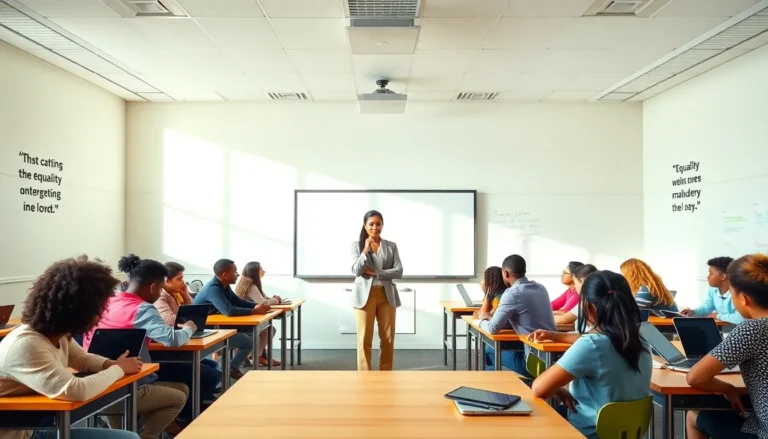Imagine a classroom where students are not just learning but also leveling up like characters in their favorite video games. Education gamification models are transforming traditional learning into a dynamic adventure. By integrating game mechanics into educational settings, these models engage students in ways that textbooks simply can’t.
Table of Contents
ToggleOverview of Education Gamification Models
Education gamification models incorporate various strategies to enhance learning experiences. These models utilize game mechanics such as points, badges, and leaderboards to motivate students. Interaction becomes central in these frameworks, engaging learners through challenges and rewards.
One effective model is the Points System. This approach rewards students with points for completing tasks, encouraging participation. Such models drive competition and help develop skills as students strive for high scores.
Another common model is Badges and Achievements. Badges reward specific accomplishments, adding a layer of recognition. This method builds intrinsic motivation, fostering a sense of pride in achievement.
The Leaderboard Model ranks students based on their performance. This visibility encourages friendly competition and increases engagement among learners. Students often aspire to climb the ranks, reinforcing their commitment to learning.
Storytelling, as a gamification model, immerses learners in narratives. With this approach, students navigate a storyline that presents challenges and victories. This method enhances retention, as participants connect emotionally with the content.
Collaboration is key in multiplayer scenarios. These models facilitate teamwork, where students work together to achieve common goals. This social interaction promotes deeper understanding and enhances communication skills.
Adaptive Learning Systems personalize the learning experience. By assessing students’ performance, these systems tailor challenges to suit individual needs. This personalization keeps students engaged and allows them to progress at their own pace.
Understanding these models helps educators select appropriate strategies. Effective implementation requires aligning gamification elements with educational goals. When done properly, education gamification creates an enriching learning environment.
Key Principles of Gamification in Education
Education gamification relies on several key principles to enhance student experiences. These principles include engagement, motivation, and effective feedback mechanisms.
Engagement
Engagement is crucial for effective learning. Game mechanics draw students into interactive activities that sustain their interest. Activities incorporating challenges encourage them to explore and discover. Social interaction among peers boosts participation, fostering a collaborative environment. Additionally, the use of visually appealing elements captures attention. Students often become more invested in their learning journey, which leads to deeper understanding and retention.
Motivation
Motivation serves as a driving force for students in gamified environments. Intrinsic motivation emerges when students pursue personal growth and mastery of subjects. The Points System rewards effort, creating a sense of achievement. Badges symbolize accomplishments, fostering pride and recognition. Incorporating competition through leaderboards encourages students to strive for excellence. When educators design gamified experiences that align with personal goals, motivation increases significantly.
Feedback Mechanisms
Feedback mechanisms play an essential role in gamification. Timely and constructive feedback helps students identify areas for improvement. Immediate responses to tasks reinforce learning and encourage growth. Students appreciate knowing their progress through clear metrics and achievements. Integrating various feedback formats, like peer evaluations and self-assessments, fosters a comprehensive understanding. When feedback is grounded in game-like elements, it enhances the overall educational experience.
Popular Education Gamification Models
Various education gamification models enhance learning experiences. These models provide distinct strategies that engage students and promote effective learning.
The Octalysis Framework
The Octalysis Framework focuses on eight core drives that motivate individuals. By incorporating elements like empowerment and social influence, educators can create tailored learning experiences. Each drive addresses different aspects of motivation, ensuring that lessons resonate with students. This model emphasizes the balance between intrinsic and extrinsic motivators, enhancing student involvement.
GBL (Game-Based Learning)
Game-Based Learning (GBL) utilizes games as tools for educational purposes. By integrating gameplay with curriculum objectives, learners develop critical thinking and problem-solving skills. GBL often includes simulations or role-playing, fostering engagement through realistic scenarios. Incorporating rewards and challenges within games maintains motivation, promoting a deeper understanding of the subject matter.
The Player-Centric Model
The Player-Centric Model centers on individual learner preferences and experiences. It prioritizes personalization in gamification, accommodating diverse learning styles and paces. By focusing on what drives each student, this model enhances engagement and promotes self-directed learning. Educators can leverage analytics to adapt content and improve outcomes, creating more impactful educational journeys.
Benefits of Education Gamification Models
Education gamification models offer distinct advantages that significantly enhance traditional learning environments. These models energize classrooms, making education an interactive experience.
Increased Student Participation
Gamification increases student participation by transforming how learners engage with their studies. Game mechanics, such as points systems and leaderboards, motivate students to actively participate in tasks, tackling challenges with enthusiasm. Educators observe a noticeable rise in class attendance when gamification is implemented. Competitive elements promote interaction among peers and foster a collaborative atmosphere. Moreover, students often take ownership of their learning, leading to increased motivation and enthusiasm. As a result, classroom dynamics shift, creating an engaging environment where students feel empowered to excel.
Enhanced Learning Outcomes
Enhanced learning outcomes emerge from educational gamification as students connect with content on a deeper level. Incorporating game-like elements captivates students’ attention, leading to improved retention rates. Research indicates that learners exposed to gamified lessons demonstrate higher mastery of concepts. Engaging in simulations and interactive activities allows for hands-on problem-solving, fostering critical thinking skills. Feedback mechanisms built into gamification provide timely insights, helping students recognize strengths and address weaknesses. Consequently, these approaches create a more effective learning cycle, driving academic success and personal growth among learners.
Challenges and Considerations
Implementing education gamification models brings several challenges that educators must navigate effectively.
Implementation Barriers
Insufficient funding often limits the ability to invest in gamification tools. Educators must also consider a lack of teacher training in integrating these methods. Resistance from traditionalist educators creates hesitation in adopting new approaches. Furthermore, technology access remains uneven, with some students unable to engage with digital platforms. Time constraints can inhibit the development and execution of gamified curricula. Addressing these barriers becomes essential for successful integration and sustainable practices in educational settings.
Balancing Fun and Learning
Maintaining a balance between entertainment and education presents another challenge. Gamification should enhance learning without overshadowing educational objectives. Clear learning outcomes must guide the design of gamified elements. Striking the right balance ensures that students remain focused on mastering concepts while enjoying the learning process. Feedback must be aligned with educational goals, reinforcing concepts while encouraging participation. Engaging activities should motivate learners, helping them connect the gamified experience with real-world applications. Prioritizing this balance strengthens the overall effectiveness of gamification in education.
Education gamification models offer innovative ways to enhance learning experiences. By integrating game mechanics into the classroom, educators can create engaging environments that motivate students and foster collaboration. As these models evolve, they provide unique strategies that cater to diverse learning styles and needs.
While challenges exist in implementing gamification, understanding key principles and models allows educators to navigate these obstacles effectively. By focusing on engagement, motivation, and feedback, they can create dynamic learning experiences that promote academic success. Ultimately, the thoughtful application of gamification in education not only enriches the learning journey but also empowers students to take ownership of their education.



